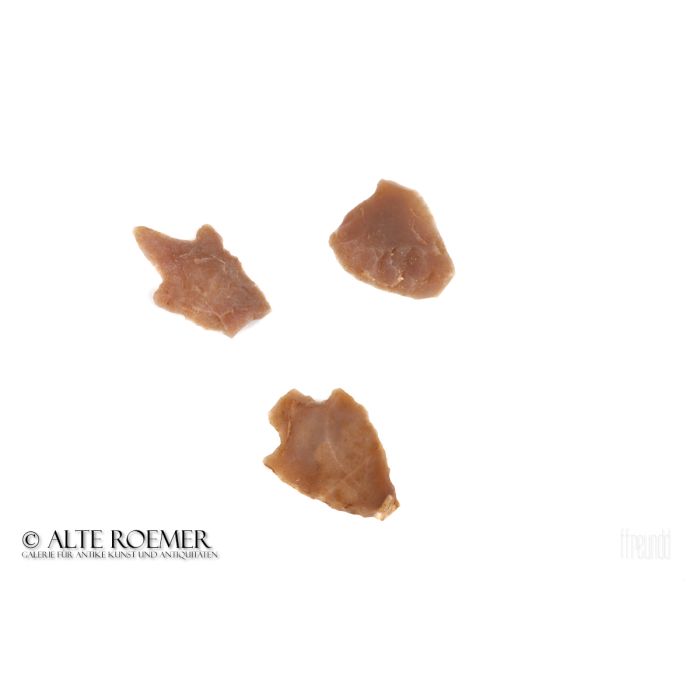Three neolithic arrowheads from Egypt
Price: on request
Sold
Object number
AR3316B03
| Object: |
Three neolithic arrowheads from Egypt
|
| Material: |
Flint.
|
| Period: |
Approx. 5000 BC to 3000 BC. Neolithic to Chalcolithic. |
| Description: |
Group of three stone arrowheads of North African type. The edges are delicately worked.
|
| Background: |
Arrowheads of this type were fired with Neolithic bow weapons. A rare piece of evidence is an arrowhead still in place on a ready-to-fire arrow. It was found in a completely different place, namely at the mummy from Hauslabjoch in the Austrian Ötztal Alps. The Iceman, better known as "Ötzi", lived a little over 5000 years ago and is the best-preserved human from that era. He carried a bow and arrow, supposedly the typical weapon of the New Stone Age (cf. Spindler 1993, 142f.; on the dating Bonani et al. 1994). Other uses for such weapon points might have been spears and lances.
|
| Dimensions: |
27mm, 27mm and 22mm long, respectively.
|
| Condition: |
A few chips as shown in the photo and the tip of one arrow head broken off and missing. Otherwise nicely preserved. All pieces with a modern inscription in black "1584".
|
| Provenance: |
Acquired by us on the Swiss art market in 2022. Previously in the Swiss collection of Alfred Huber, acquired in 1998 when Mr. Huber was director of the Burghalde Museum in Lenzburg, Switzerland. The acquisition was made from the collection of the Bally-Prior Museum in Schönenwerd, Switzerland. Added to the museum collection between 1860 and 1926. Egypt is probably the place of origin. An invitation and encouragement to devote oneself to the study of art and nature and to love the subject. This is what the Bally-Prior Museum should be for the youth. And this is why the founder of the museum granted free admission to young visitors. He himself, Peter Eduard Bally-Prior (1847-1926), began collecting early in his life. He passionately devoted himself to minerals, fossils, as well as archaeological and ethnological rarities. His successful career as an industrialist and Swiss National Council gave him ample funds for his passion. He financed six large archaeological excavations in Switzerland and took the time to write accademic publications on history. The Bally-Prior Museum in Schönenwerd Switzerland opened in 1910 to make the already huge collection accessible to the public. Shortly before the death of the founder in 1926, the museum opened a new wing to accommodate new additions to the collection. After almost a century, in 1998, the museum foundation decided to close down and sell the exhibits. Museums, universities and private individuals rushed to acquire a part. It was people who had love for the subject. Exactly the passion Eduard Bally-Prior wanted to awaken with his museum. |
| References: |
Cf. C. E. Klenkler, Sahara - Objects Prehistoriques / Prähistorische Artefakte, p. 68. Cf. D. Greenwell, Flint Artifacts of North Africa, pp. 115 and 116. |
| Literature: |
J. Friis-Hansen, Mesolithic cutting arrows: functional analysis of arrows used in the hunting of large game. Antiquity 64 (1990), pp. 494 to 504.
|
| Authenticity: |
We unconditionally guarantee the authenticity of every artefact, all items are subject to our lifetime return policy on authenticity.
|


